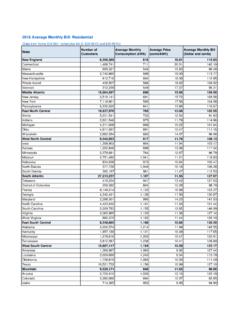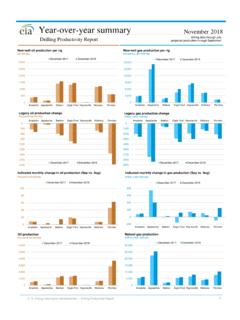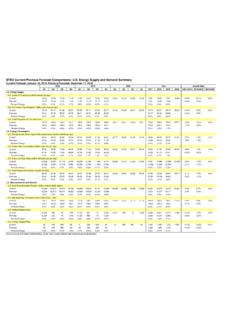Transcription of Battery Storage in the United States: An Update on Market ...
1 Battery Storage in the United States: An Update on Market Trends August 2021 Independent Statistics & Analysis Department of Energy Washington, DC 20585 Energy Information Administration | Battery Storage Market Trends i This report was prepared by the Energy Information Administration (EIA), the statistical and analytical agency within the Department of Energy. By law, EIA s data, analyses, and forecasts are independent of approval by any other officer or employee of the United States Government. The views in this report therefore should not be construed as representing those of the Department of Energy or other federal Energy Information Administration | Battery Storage Market Trends ii List of Acronyms AEO Annual Energy Outlook AK/HI Alaska and Hawaii CAES Compressed-air energy Storage CAISO california Independent System Operator CPUC california Public Utility Commission CSP Concentrated solar power DOE Department of Energy EIA Energy Information Administration ERCOT Electric Reliability Council of Texas FERC Federal Energy Regulatory Commission GW Gigawatt IOU Investor-owned utilities ITC Investment Tax Credit IPP Independent power producer IRP Integrated resource plan ISO Independent System Operator ISO-NE Independent System Operator of New England kW Kilowatt kWh Kilowatthour LADWP Los Angeles Department of Water and Power MISO Midcontinent Independent System Operator MW
2 Megawatt MWh Megawatthour NEMS National Energy Modeling System NYISO New York Independent System Operator PGE Pacific Gas and Electric PJM PJM Interconnection PPA Power purchase agreement RTO Regional Transmission Organization SCE Southern california Edison SDGE San Diego Gas and Electric SGIP self - generation Incentive Program SMUD Sacramento Municipal Utility District SPP Southwest Power Pool Energy Information Administration | Battery Storage Market Trends iii Table of Contents List of Acronyms .. ii List of Figures .. iv List of Tables .. iv Executive Summary .. 1 Large-Scale Battery Storage Trends .. 5 Regional trends .. 5 Ownership trends .. 9 Chemistry Trends .. 10 Current Applications .. 13 Application descriptions .. 13 Applications by region .. 14 Battery Storage Costs .. 16 Cost background .. 16 Cost results .. 17 Battery Utilization Trends .. 20 Small-Scale Energy Storage Trends .. 22 Small-scale Storage trends in california .
3 22 Small-scale energy Storage trends in the rest of the United States .. 23 Market and Policy Drivers .. 24 Wholesale Market rules .. 24 Federal-level policy actions .. 25 State-level policy actions .. 25 Ongoing Trends .. 28 Near-term planned capacity additions (2020 2023) .. 28 Co-located Battery Storage projects .. 29 Long-term projected capacity additions (2020 2050) .. 31 Appendix A: Data Concepts .. 34 Appendix B: Other Storage Technologies .. 35 Appendix C: Installed Power and Energy Capacity of Large-Scale Batteries by State .. 37 Energy Information Administration | Battery Storage Market Trends iv List of Figures Figure 1. Large-scale power and energy capacity by region (2019) .. 6 Figure 2. Large-scale Battery Storage installations by region (2019) .. 7 Figure 3. Large-scale Battery Storage capacity by region (2010 2019) .. 8 Figure 4. Power capacity and duration of large-scale Battery Storage by region (2019).
4 9 Figure 5. Large-scale Battery Storage capacity by region and ownership type (2019) .. 10 Figure 6. Large-scale Battery Storage capacity by chemistry (2003 2019) .. 11 Figure 7. Applications served by large-scale Battery Storage (2019) .. 14 Figure 8. Total installed cost of large-scale Battery Storage systems by duration (2013 2019) .. 17 Figure 9. Total installed cost of large-scale Battery Storage systems by year .. 18 Figure 10. Large-scale Battery Storage gross generation and usage factor by region (2019) .. 20 Figure 11. Small-scale energy Storage capacity by sector (2019) .. 22 Figure 12. Small-scale energy Storage capacity outside of california by sector (2019) .. 23 Figure 13. Large-scale Battery Storage cumulative power capacity, 2015 2023 .. 28 Figure 14. Large-scale Battery Storage power capacity by region and co-located generator, operating and planned .. 29 Figure 15. large-scale Battery Storage power capacity, standalone and co-located.
5 30 Figure 16. Large-scale co-located Battery Storage and generator power capacity by region .. 31 Figure 17. AEO2021 diurnal energy Storage capacity by case .. 32 Figure 18. AEO2021 power generation by technology and case, 2050 .. 33 Figure 19. Hydroelectric pumped Storage capacity (1960 2019) .. 35 List of Tables Table 1. Sample characteristics of capital cost estimates for large-scale Battery Storage by duration (2013 2019) .. 16 Table 2. Sample characteristics of capital cost estimates for large-scale Battery Storage by year .. 18 August 2021 Energy Information Administration | Battery Storage Market Trends 1 Executive Summary Electric power markets in the United States are undergoing significant structural change that we believe, based on planning data we collect, will result in the installation of the ability of large-scale Battery Storage to contribute 10,000 megawatts to the grid between 2021 and 2023 10 times the capacity in 2019.
6 Energy Storage plays a pivotal role in enabling power grids to function with more flexibility and resilience. In this report, we provide data on trends in Battery Storage capacity installations in the United States through 2019, including information on installation size, type, location, applications, costs, and Market and policy drivers. The report then briefly describes other types of energy Storage . This report focuses on data from EIA survey respondents and does not attempt to provide rigorous economic or scenario analysis of the reasons for, or impacts of, the growth in large-scale Battery Storage . Growth across electric power Market regions The number and total capacity of large-scale Battery Storage systems continue to grow in the United States, and regional patterns strongly influence the nation-wide Market structure: At the end of 2019, 163 large-scale Battery Storage systems were operating in the United States, a 28% increase from 2018.
7 The maximum energy that could be stored at these sites (energy capacity) was 1,688 megawatthours (MWh), and the maximum power that could be provided to the grid from these sites at any given moment (power capacity) was 1,022 megawatts (MW). As of the end of 2019, more than 60% of the large-scale Battery system capacity to store energy or provide power to the grid in the United States was located in areas covered by regional grid operators PJM Interconnection (PJM) and california Independent System Operator (CAISO). Historically, these areas attracted capacity additions because of favorable Market rules promoting energy Storage . Starting in 2017, regions outside of PJM and CAISO have also seen installations of large-scale Battery energy Storage systems, in part as a result of declining costs. A breakout of installed power and energy capacity of large-scale Battery by state is attached as Appendix C.
8 August 2021 Energy Information Administration | Battery Storage Market Trends 2 Figure ES1. Large-scale Battery Storage capacity by region (2010 2019) power capacity energy capacity megawatts megawatthours Source: Energy Information Administration, 2019 Form EIA-860, Annual Electric Generator Report Small-scale Battery Storage Small-scale Battery Storage also continues to grow, especially in california , but also in other regions of the United States: In 2019, 402 MW of small-scale total Battery Storage power capacity existed in the United States. california accounts for 83% of all small-scale Battery Storage power capacity. The states with the most small-scale power capacity outside of california include Hawaii, Vermont, and Texas. Lower installed costs The costs of installing and operating large-scale Battery Storage systems in the United States have declined in recent years.
9 Average Battery energy Storage capital costs in 2019 were $589 per kilowatthour (kWh), and Battery Storage costs fell by 72% between 2015 and 2019, a 27% per year rate of decline. These lower costs support more capacity to store energy at each Storage facility, which can increase the duration that each Battery system can last when operating at its maximum power. August 2021 Energy Information Administration | Battery Storage Market Trends 3 power capacity costs energy capacity costs dollars per kilowatt dollars per kilowatthour Source: Energy Information Administration, 2019 Form EIA-860, Annual Electric Generator Report More direct support from solar power Most large-scale Battery energy Storage systems we expect to come online in the United States over the next three years are to be built at power plants that also produce electricity from solar photovoltaics, a change in trend from recent years.
10 As of December 2020, the majority of large-scale Battery Storage systems were built as standalone facilities, meaning they were not located at sites that generate power from natural resources. Only 38% of the total capacity to generate power from large-scale Battery Storage sites was co-located with other generators: 30% was co-located specifically with generation from renewable resources, such as wind or solar PV, and 8% was co-located with fossil fuel generators. We expect the relationship between solar energy and Battery Storage to change in the United States over the next three years because most planned upcoming projects will be co-located with generation , in particular with solar facilities. If all currently announced projects from 2021 to 2023 become operational, then the share of Battery Storage that is co-located with generation would increase from 30% to 60%. Figure ES2. Total installed cost of large-scale Battery Storage systems by year August 2021 Energy Information Administration | Battery Storage Market Trends 4 Figure ES3.












